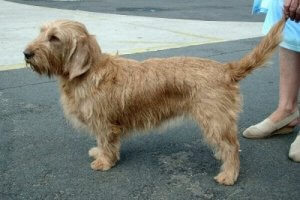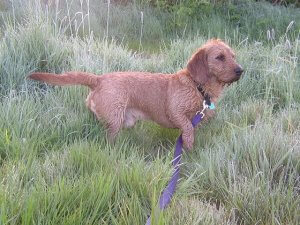The Basset Fauve de Bretagne: A Champion Scenthound

The Basset Fauve de Bretagne is a member of the scenthound family, and is used to track down prey. While these dogs have an incredibly striking appearance, it’s their extraordinary sense of smell that has led them to become champion scenthounds, and achieve worldwide fame.
Origins
The Basset Fauve de Bretagne is a direct descendant of the Griffon Fauve de Bretagne, another famous hunting dog. Originally bred in the Brittany region of France, the breed first began to take off during the 19th Century. However, it wasn’t until the end of the 20th century that they truly began to find fame. It was then they started to win awards for rabbit hunting. As well as making great family pets, they continue to be used as hunting dogs even today.
The Basset Fauve de Bretagne – characteristics
The Basset Fauve de Bretagne measures between 12 ½ and 15 inches at the shoulders, and is considered a medium-sized breed.
They have long, elongated heads, with muzzles longer than their skulls. Their jowls are slightly longer than other breeds, but don’t hang down excessively like those of other scenthounds. However, they do have one typical scenthound characteristic: long, triangular ears. They usually don’t grow down past the jawline, and are covered in short, velvety fur.
It should also be noted that their front legs are very short in comparison to the length of their hind legs, and out of proportion with the size of their body. The body is slightly longer than normal, while their chests are deep and muscular.
Their physique makes them perfectly suited to hunting rabbits: the short front legs make it easy for them to move quickly with their noses close to the ground, without it being uncomfortable for them. At the same time their muscular bodies allow them to run long distances while following a scent.
Although their fur is fairly long, it’s coarse, and doesn’t tangle easily. It should be cut short around the face to allow them to see properly. They come in a variety of different colors, ranging from fawn to red wheaten.
Some also have white markings on their chests, and it’s common for them to have black hairs here and there. The eyes aren’t too large or too small, nor are they particularly close together or far apart.
Behavior
While their athletic stature allows them to pursue their passion for hunting, they also make great pets. These are sociable and affectionate animals that form strong attachments to their human family. They have a great ability to adapt to new situations, a skill which has allowed them to be efficient trackers on all different kinds of terrain. Nowadays, it also means they can be happy wherever they are, as long as they’re with their owners.

They’re energetic dogs that require plenty of physical and mental exercise. A happy Basset Fauve is one that can run around in dense woodland and follow any trails it picks up – whether you personally want to hunt them or not. They move quickly and agilely, enjoying plenty of freedom and the chance to explore all kinds of interesting scents.
Like other hunting dogs, such as the terrier, they often have strong personalities. They’re friendly and affectionate, but aren’t afraid to make their opinions and feelings known. They’re also very tenacious – when they set their sights on something, they don’t tend to stop until they get it. This tenacity stems from their great intelligence. When they want something, they’ll try to think up every possible solution, and rarely give up.
Caring for your Basset Fauve de Bretagne
The Basset’s coat is easy to maintain. It will need regular brushing, but because it’s quite rough and doesn’t tangle, it’s easy to keep healthy. They don’t usually molt too much, although they will need brushing more often at the beginning of spring and fall.
This breed doesn’t usually suffer from any major health issues, although their stature does make them more likely to suffer from certain conditions. For example, dogs with short legs and long bodies often develop back problems. Plus, when caring for hound-type breeds with long, droopy ears, you always need to pay particular attention to ear hygiene. It’s all too easy for these dogs to get ear infections and other issues.
When it comes to training, it’s important to be aware that this is a difficult breed to discipline. Keep in mind that these are tenacious, fearless animals, and they can’t be manipulated with traditional dominance techniques. The Basset Fauve de Bretagne responds best to positive reinforcement. It’s always happy to learn if there are treats on offer.
The Basset Fauve de Bretagne is a member of the scenthound family, and is used to track down prey. While these dogs have an incredibly striking appearance, it’s their extraordinary sense of smell that has led them to become champion scenthounds, and achieve worldwide fame.
Origins
The Basset Fauve de Bretagne is a direct descendant of the Griffon Fauve de Bretagne, another famous hunting dog. Originally bred in the Brittany region of France, the breed first began to take off during the 19th Century. However, it wasn’t until the end of the 20th century that they truly began to find fame. It was then they started to win awards for rabbit hunting. As well as making great family pets, they continue to be used as hunting dogs even today.
The Basset Fauve de Bretagne – characteristics
The Basset Fauve de Bretagne measures between 12 ½ and 15 inches at the shoulders, and is considered a medium-sized breed.
They have long, elongated heads, with muzzles longer than their skulls. Their jowls are slightly longer than other breeds, but don’t hang down excessively like those of other scenthounds. However, they do have one typical scenthound characteristic: long, triangular ears. They usually don’t grow down past the jawline, and are covered in short, velvety fur.
It should also be noted that their front legs are very short in comparison to the length of their hind legs, and out of proportion with the size of their body. The body is slightly longer than normal, while their chests are deep and muscular.
Their physique makes them perfectly suited to hunting rabbits: the short front legs make it easy for them to move quickly with their noses close to the ground, without it being uncomfortable for them. At the same time their muscular bodies allow them to run long distances while following a scent.
Although their fur is fairly long, it’s coarse, and doesn’t tangle easily. It should be cut short around the face to allow them to see properly. They come in a variety of different colors, ranging from fawn to red wheaten.
Some also have white markings on their chests, and it’s common for them to have black hairs here and there. The eyes aren’t too large or too small, nor are they particularly close together or far apart.
Behavior
While their athletic stature allows them to pursue their passion for hunting, they also make great pets. These are sociable and affectionate animals that form strong attachments to their human family. They have a great ability to adapt to new situations, a skill which has allowed them to be efficient trackers on all different kinds of terrain. Nowadays, it also means they can be happy wherever they are, as long as they’re with their owners.

They’re energetic dogs that require plenty of physical and mental exercise. A happy Basset Fauve is one that can run around in dense woodland and follow any trails it picks up – whether you personally want to hunt them or not. They move quickly and agilely, enjoying plenty of freedom and the chance to explore all kinds of interesting scents.
Like other hunting dogs, such as the terrier, they often have strong personalities. They’re friendly and affectionate, but aren’t afraid to make their opinions and feelings known. They’re also very tenacious – when they set their sights on something, they don’t tend to stop until they get it. This tenacity stems from their great intelligence. When they want something, they’ll try to think up every possible solution, and rarely give up.
Caring for your Basset Fauve de Bretagne
The Basset’s coat is easy to maintain. It will need regular brushing, but because it’s quite rough and doesn’t tangle, it’s easy to keep healthy. They don’t usually molt too much, although they will need brushing more often at the beginning of spring and fall.
This breed doesn’t usually suffer from any major health issues, although their stature does make them more likely to suffer from certain conditions. For example, dogs with short legs and long bodies often develop back problems. Plus, when caring for hound-type breeds with long, droopy ears, you always need to pay particular attention to ear hygiene. It’s all too easy for these dogs to get ear infections and other issues.
When it comes to training, it’s important to be aware that this is a difficult breed to discipline. Keep in mind that these are tenacious, fearless animals, and they can’t be manipulated with traditional dominance techniques. The Basset Fauve de Bretagne responds best to positive reinforcement. It’s always happy to learn if there are treats on offer.
This text is provided for informational purposes only and does not replace consultation with a professional. If in doubt, consult your specialist.








